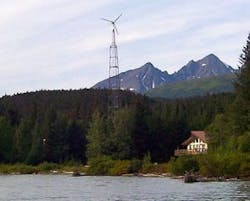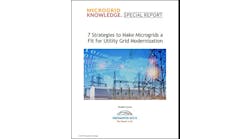Wind turbine in Primrose, Alaska. Credit: Beeblebrox
Peter Asmus, of Navigant Research, recently traveled to Alaska to explore its wind microgrids. He explains why Alaska has a lot to show the rest of the world about creating resiliency.
Alaska was in the midst of a heat wave when I arrived there in early March, with temperatures hovering around the freezing mark, and reaching 40 °F the day I left. The lack of snow forced the annual Iditarod dog sled race to a new route farther north, a sign many locals attributed to global climate change.
I went to Alaska because the state is ground zero for microgrids, with more deployed here than any other state in the United States, with some nearly 100% supplied with renewable energy. Alaska’s often harsh environment means that microgrid performance can literally be a life-or-death situation. When one such system failed more than a decade ago in Kotzebue, a city with a population of 3,700 and located 30 miles above the Arctic Circle, the entire water and wastewater system froze, and it took months to bring water back online.
Call to Arms
Held in Anchorage, the Islanded Grid Wind Power Conference demonstrated that Alaska can show the rest of the world how to create more resilient and sustainable power systems in the face of immense logistical challenges. While the rest of the world seems to be turning to solar power, wind is still king in Alaska, where towns like Kotzebue only have 35 days during summer where the sun rises above the horizon.
Most microgrids in Alaska are run by utilities—rural cooperatives, municipal utilities, or Native Alaska village corporations. Some of these entities, especially tiny villages on remote islands, have limited operational capacity, so technology choices must be wise and easily reparable. That’s why some companies, such as Intelligent Energy Systems, often rely upon older turbines that can be fixed the old fashioned way: with a wrench.
Beyond Diesel
Other companies, such as TDX Power, an Alaskan Native corporation created by individuals whose ancestors were the slaves of Russian fur trappers, are building innovative wind heating systems that validate the thermal energy benefits microgrids bring to the table. They’re also investigating new business models, given that Alaska is now about $4 billion in the red due to declining oil prices. Ironically enough, this shortfall is limiting future financial support for renewable energy development, forcing developers to find creative microgrid financing solutions.
Perhaps the most interesting company I saw was Innovus Power of Fremont, California. Innovus offers variable-speed diesel generators that come embedded with what is, in essence, a microgrid controller capable of supporting renewable penetration levels of up to 100%. Leveraging power converter innovation from Northern Power, the company says its gensets can eliminate the need for curtailment or expensive energy storage, and can serve as backbones for microgrids that combine dispatchable power and renewable integration capabilities.
Governor Bill Walker pointed out that while Alaska has more energy resources than any other U.S. state, its power prices are the highest. Microgrids integrating renewable energy are a key part of the future strategy to change that situation.
Peter Asmus is a principal research analyst for Navigant Research. This blog originally appeared on Navigant Research’s blog.







